Guttation in Cannabis: What It Is, Why It Happens, and How to Respond
TL;DR (Grower’s Quick Take)
- What you’re seeing: beads at leaf margins/tips before lights-on.
- Why it happens: moist root zone + cool/humid air + low airflow → root pressure pushes xylem fluid out of hydathodes.
- What’s in it: mostly water plus minerals (K⁺, NO₃⁻, Ca²⁺), organic acids, amino acids, trace sugars/proteins; dries to whitish/brown flecks.
- Is it a problem? Usually benign; it’s a signal to tune irrigation timing, night RH/VPD, and airflow.
- Don’t confuse with: dew (condenses from air), honeydew (sticky insect excretion), or resin (from glandular trichomes, not leaf edges). (labs.plb.ucdavis.edu, Integrated Pest Management, PubMed, Frontiers)
1) What is Guttation? (in plain English)
Guttation is when a plant “pushes out” tiny droplets at the very edges or tips of its leaves—most noticeable late night to early morning. It happens because roots keep taking up water while stomata are mostly closed, so positive pressure in the xylem forces fluid out through always-open pores called hydathodes at the ends of leaf veins. (labs.plb.ucdavis.edu, Integrated Pest Management)
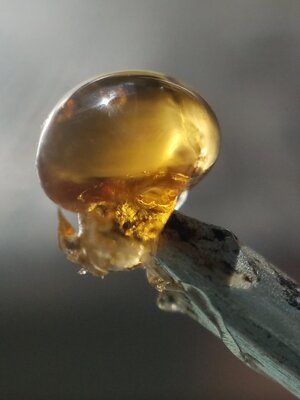
("Guttation droplet from a Sweet Seeds Red Poison Autoflower" - Source: Autoflower.org, Author: Jordan Harker)
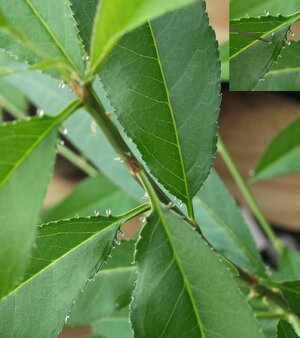
"Droplets of guttation exudate on hydathodes of nectarine leaves" - Source: Askune, Author: Askune)
2) The Scientific Version (What/Why/How/When)
Hydathodes & anatomy
Hydathodes are specialized structures at leaf margins/tips where minor veins terminate. Beneath the surface, an epithem (spongy parenchyma) connects those vein endings to an epidermal water pore—a low-resistance path for liquid release. (Cell)
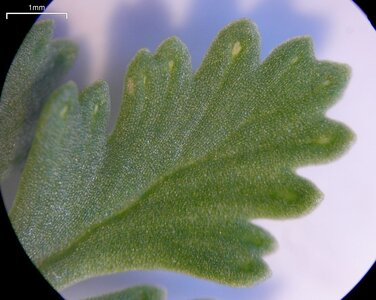
("An extreme close-up (30x) shows the hydathodes at the end of the veins of a leaf. Notice how the veins terminate back from the margins somewhat." - Source: American Rock Brake Hydathode, Author: Jason Hollinger)
Mechanism
At night (low transpiration), ion loading in roots lowers root water potential; water follows osmotically, creating root pressure that moves xylem sap to leaves and out through hydathodes as guttation droplets. Cool, humid air and saturated media amplify the effect. Expect the most visible droplets before sunrise / lights-on. (labs.plb.ucdavis.edu, Integrated Pest Management)
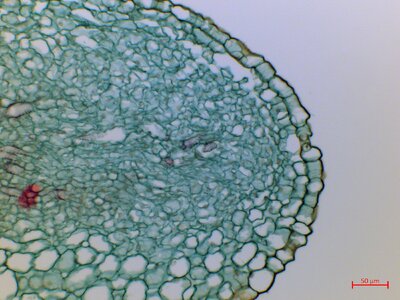
("Microscopic close-up of hydathode" - Source: Brassica_Hydathode_1, Author: Plant Image Library from Boston, USA)
Where to look on cannabis
Droplets appear at leaflet tips and serration ends—the common positions of hydathodes. (Cannabis-specific hydathode maps are limited, but this matches broad vascular-plant anatomy.) (Cell)
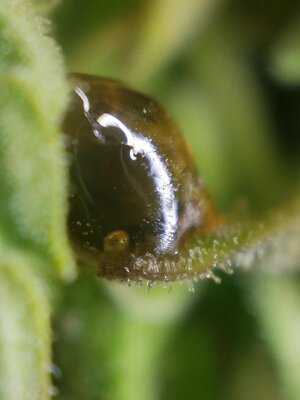
(Source: Autoflower.org, Author: Jordan Harker)
3) What’s in Guttation Droplets? (Composition)
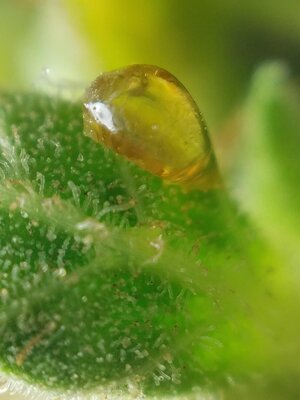
(Source: Autoflower.org, Author: Jordan Harker)
Guttation fluid is not pure water. Analyses across crops show water plus mineral ions (K⁺, NO₃⁻/PO₄³⁻/Cl⁻/Ca²⁺), organic acids (e.g., malate/citrate), amino acids, and trace sugars/proteins; composition shifts with nutrition, age, and reabsorption at the hydathode. When droplets dry, they can leave white/brown mineral specks at tips. (PubMed, Cell, PMC)
Side note (residues in other crops): Studies across crops like corn and melons have shown that systemic insecticides such as neonicotinoids, when applied as seed coatings or soil drenches, can be detected in guttation droplets at significant concentrations. Because guttation fluid is xylem sap exuded through hydathodes, these findings provide direct evidence that such pesticides are translocated through the xylem and released in guttation. This confirms that systemic actives move throughout the plant via xylem flow and can appear in guttation as dissolved solutes. (Physiology example only; not a cultivation recommendation.) (PubMed, BioOne)
In the context of cannabis cultivation, this has important implications. Unlike many agricultural products that are washed, peeled, or cooked, cannabis is often directly inhaled (smoked or vaporized), ingested (edibles, oils), or applied topically with minimal processing to remove chemical residues. Systemic pesticides that persist in plant tissues—especially in flowers, resins, or extracts—pose potential risks for consumer exposure, since combustion, vaporization, or ingestion can deliver residues into the body.
Therefore, cultivators should exercise caution in selecting pest-management tools. Regulatory frameworks in many regions already prohibit or strictly limit pesticide use in cannabis because of the direct human exposure pathway and the lack of established safe tolerance levels. Integrated pest management (IPM), biological controls, and approved low-risk pesticides are often recommended alternatives.
4) Conditions that Favor Guttation (and what to tweak)
- Root zone: recently watered / media kept wet → higher root pressure.
- Air: cool, humid nights and low airflow → suppressed transpiration.
- Canopy: dense leaves and limited spacing → boundary layers hold humidity.
- Plant stage: vigorous, well-hydrated young plants show it more often.
Tweak by letting media breathe between irrigations, avoiding saturating right before dark, raising gentle night airflow, and keeping RH in range. (Integrated Pest Management)
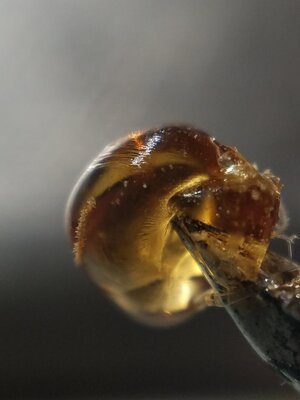
("Source: Autoflower.org, Author: Jordan Harker)
5) Guttation vs Dew vs Honeydew vs Resin (how to tell)
| Feature | Guttation | Dew | Honeydew (insects) | Resin (trichomes) |
|---|---|---|---|---|
| Source | Xylem-derived fluid pushed out | Air moisture condensing on a cool surface | Sugary excretion from sap-feeders (aphids/whiteflies) | Metabolites secreted by glandular trichomes |
| Where | Leaf tips/margins at vein endings (hydathodes) | Any exposed surface | Random patches/surfaces below infestations | Bracts (“buds”) & sugar leaves; from trichome heads |
| Texture | Watery; dries to mineral flecks | Pure water | Sticky, attracts ants, can grow sooty mold | Oily/viscous, aromatic cannabinoids/terpenes |
| Timing | Night → early morning | Early morning | Anytime pests active | Throughout flowering |
| Action | Usually benign; adjust irrigation/RH/airflow | None | Scout & manage pests | Normal floral development |
Citations: guttation & dew basics, hydathodes locations, honeydew traits, resin/trichomes anatomy. (labs.plb.ucdavis.edu, Integrated Pest Management, UC IPM, Frontiers)
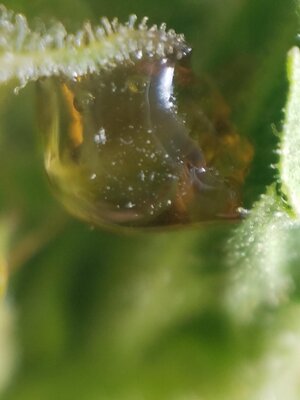
("Source: Autoflower.org, Author: Jordan Harker)
6) Practical Checklist (Grow Room/Greenhouse)
- Confirm it’s guttation: beads at tips/edges, pre-lights-on, non-sticky; leaves salt specks as it dries. If you see sticky films, ants, or sooty mold, inspect for insects. (UC IPM)
- Irrigation timing: avoid heavy fertigation right before dark; favor pulse watering (watering in shorter, infrequent bursts) that allows gas exchange in the medium.
- Night climate: add air movement, keep RH/VPD in target range, thin overly dense foliage if needed.
- Hygiene: blot droplets from critical floral tissues in very humid rooms; hydathodes are known microbe entry sites in several crops. (Cell)
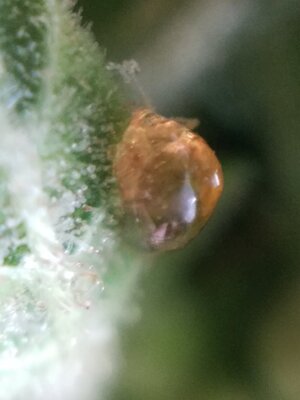
("Source: Autoflower.org, Author: Jordan Harker)
7) Troubleshooting table
Symptom | Likely cause | Quick action |
|---|---|---|
| Frequent beads at many leaflet tips every morning | Saturated media + cool/humid nights → high root pressure | Reduce late-day irrigation; increase gentle night airflow; review RH setpoints. (Integrated Pest Management) |
| Crusty white/brown flecks at serration tips | Guttation drying leaves mineral residues | Normal; consider small irrigation/RH tweaks if cosmetic issue. (PubMed) |
| Sticky film on upper leaf surfaces; ants/sooty mold | Honeydew from sap-feeders | Scout undersides; manage pests; clean residues. (UC IPM) |
| “Sweat” mistaken for resin on fan leaves | Guttation at margins/tips vs resin from trichomes on bracts/leaves | Verify location/texture; resin is viscous/aromatic from trichomes, not liquid droplets at tips. (Frontiers) |
8) Myth-busting
- “It’s dew.” No—dew condenses from air and is pure water; guttation originates inside the plant and exits at hydathodes. (labs.plb.ucdavis.edu)
- “It’s sticky resin or a pool of THC.” No—resin comes from glandular trichomes (especially on bracts), not from margin pores. (Frontiers)
- “It means overwatering, always.” Not necessarily. It signals a nighttime imbalance (wet roots + low transpiration). Tune timing, RH, and airflow before over-correcting irrigation. (Integrated Pest Management)
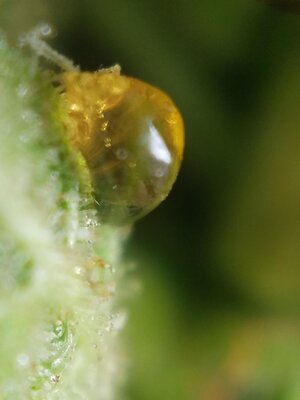
("Source: Autoflower.org, Author: Jordan Harker)
References (selected, open-web)
- UC Davis Plant Biology notes: root pressure & guttation; dew vs guttation. (labs.plb.ucdavis.edu)
- University of Missouri Extension: conditions, hydathodes at margins/tips. (Integrated Pest Management)
- Hydathodes review, Current Biology (2022): organ anatomy (water pores, epithem), physiology, and immunity context. (Cell)
- Arabidopsis hydathodes, The Plant Journal (2024): nutrient scavenging/auxin and metabolite retention near hydathodes. (Wiley Online Library)
- Composition exemplars: cereals guttation amino acids/sugars (1966); rice hydathode reabsorption. (PubMed, PMC)
- Honeydew differentiation & sooty mold: UC IPM. (UC IPM)
- Systemic residues case studies (illustrative physiology in other crops): Girolami 2009 (maize), Hoffmann 2012 (melon). (BioOne, PubMed)
Attribution / Reuse
This article was compiled from peer-reviewed literature and extension resources for educational use on Autoflower.org. Where cannabis-specific anatomy data are limited, inferences follow well-documented angiosperm leaf hydathode patterns and current plant physiology.
